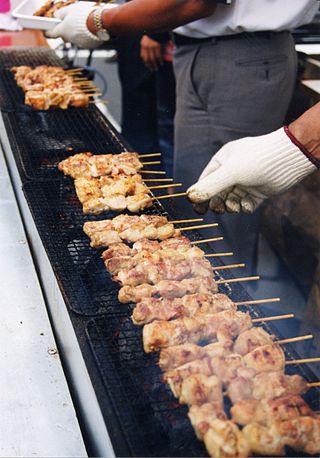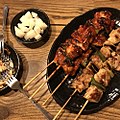
Oden is a type of nabemono consisting of several ingredients such as boiled eggs, daikon or konjac, and processed fishcakes stewed in a light, soy-flavored dashi broth.

Satay, or sate in Indonesian spelling, is a Southeast Asian form of kebab made from seasoned, skewered and barbecued meat, served with a sauce.

A skewer is a thin metal or wood stick used to hold pieces of food together. The word may sometimes be used as a metonym, to refer to the entire food item served on a skewer, as in "chicken skewers". Skewers are used while grilling or roasting meats and fish, and in other culinary applications.

Kebab, kabob, or kebap or kabab is roasted meat that originates from the Middle East and has been popularised by Iranian cuisine and Turkish cuisine. Many variants of the category are popular around the world, including the skewered shish kebab and the doner kebab with bread.

Bulgogi, literally "fire meat") is a gui made of thin, marinated slices of meat, most commonly beef, grilled on a barbecue or on a stove-top griddle. It is also often stir-fried in a pan in home cooking. Sirloin and rib eye are frequently used cuts of beef for the dish. The dish originated from northern areas of the Korean Peninsula, but is a very popular dish in South Korea, where it can be found anywhere from upscale restaurants to local supermarkets as pan-ready kits.

Allium fistulosum, the Welsh onion, also commonly called bunching onion, long green onion, Japanese bunching onion, and spring onion, is a species of perennial plant, often considered to be a kind of scallion.

Sosatie is a traditional South African dish of meat cooked on skewers. The term derives from sate and saus. It is of Cape Malay origin, used in Afrikaans, the primary language of the Cape Malays, and the word has gained greater circulation in South Africa. Marinated, cubed meat is skewered and cooked by braaing (barbecued) shish-kebab style. Sosatie recipes vary, but commonly the ingredients can include cubes of lamb, beef, chicken, dried apricots, red onions and mixed peppers.

Hongdae is a neighborhood in Seoul, South Korea near Hongik University, after which it is named. It is known for its urban arts and indie music culture, local shops, clubs, cafés and entertainment. The area is located in Mapo District in the western end of Seoul, stretching from Seogyo-dong, Hapjeong-dong & Seogang-dong.

Quail eggs are a kind of eggs as food, eaten and considered a delicacy in many parts of the world, including Asia, Europe, and North America. In Japanese cuisine, they are sometimes used raw or cooked as tamago in sushi and often found in bento lunches.

Beondegi (번데기), literally "pupa", is a Korean insect-based street food made with silkworm pupae.

The Perfect Couple is a 2007 South Korean film.

Kushiyaki (串焼き) is a formal term that encompasses both poultry and non-poultry items, skewered and grilled. At times, restaurants group them as kushimono (串物) and yakimono.

Yakitori is a Japanese type of skewered chicken. Its preparation involves skewering the meat with kushi (串), a type of skewer typically made of steel, bamboo, or similar materials. Afterwards, it is grilled over a charcoal fire. During or after cooking, the meat is typically seasoned with tare sauce or salt. The term is sometimes used informally for kushiyaki in general.

Amphioctopus fangsiao, called webfoot octopus, is a species of octopus, a cephalopod belonging to the genus Amphioctopus. It is found in the Pacific Ocean, including off the coasts of New Zealand as well as in the Yellow Sea and surrounding Chinese shores. It is also commercially fished.

Sanjeok is a type of jeok in Korean cuisine. It is usually made by placing seasoned slices of beef with vegetables on a skewer and grilling them. All the ingredients are sliced into 5–6 cm (2.0–2.4 in) long pieces. Unlike other jeok dishes, sanjeok is not dredged with flour or egg-washed before being grilled. Sanjeok may be used in jesa or eaten as banchan.

Street food in South Korea has traditionally been seen as a part of popular culture in Korea. Historically, street food mainly included foods such as eomuk, bungeo-ppang and tteok-bokki. Street food has been sold through many types of retail outlets, with new ones being developed over time.

Dak-kkochi is a popular South Korean street food consisting of small pieces of chicken and scallions grilled on a skewer.
Chicken skewers may refer to:

Tteok-kkochi is a popular South Korean street food consisting of skewered and fried tteok brushed with spicy gochujang-based sauce.






















